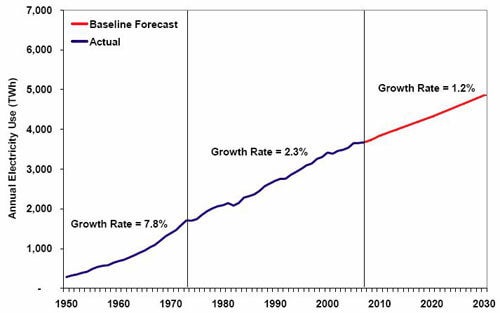
Tough economic times forces people to reevaluate where their money is going, and for most people, the cost of electricity takes a sizeable bite out of monthly income, with the average American electric bill running at $105 per month. Considering that the United States is the top electric power consumer in the world (although only tenth in consumption per capita), saying we’re addicted to the stuff is an understatement. Finding ourselves at the beginning of the digital age that has unleashed a flood of technological devices doesn’t bode well for kicking our habit anytime soon either. However, a recent study by the Electric Power Research Institute suggests a silver lining in our dependency: electrical consumption is expected to get closer to leveling off over the next two decades, even with the expected population growth. Twenty years is a long time, but here’s hoping we can break even after 2030.
It’s pretty easy to understand why the U.S. loves electricity to the tune of 3.7 trillion kWh in 2009. The post-World War II era popularized a variety of technological innovations, such as the television, refrigerator, washing machine, and air conditioning. The growing demand for appliances and entertainment meant larger houses to put all the stuff in. Consider that the average new home in 1950 was 963 square feet compared to the 2,266 square foot homes built in 2000. A single television may have been enough for entertainment in 1950, but today, multiple TVs are common, with one typically having its own entertainment center, in addition to computers, smart phones, tablets, and game consoles.
From 1950 to 1973, electricity usage was increasing an average of 7.8% annually. Then the oil crisis occurred causing consumption to be reevaluated on a variety of fronts and that’s when an interesting shift in the trends occurred. Between 1973 and 2007, electricity usage only rose 2.3% annually. While it would be nice to believe that the decrease was due to Americans taking conservation seriously, it turns out that much of the decrease in usage was primarily due to how products were manufactured, specifically related to their electrical efficiency.
But what is efficiency really? For those who ever had the opportunity (or misfortune) of learning thermodynamics, you may recall that efficiency is the power output divided by the power input expressed as a percentage. The less efficient a device is, the more it wastes the energy it consumes, typically as heat. This is why so many electrical devices get hot. But that is slowly changing.
Consider the incandescent light bulb of (almost) yesteryear. There’s a good reason that a 100-watt light bulb was inside an Easy-Bake Oven: 98% of its input energy was lost as heat. That you can bake a cake with an incandescent light bulb has always been a testament to their great inefficiency. The newer fluorescent bulbs are four to six times more efficient, which means that a lot of energy is still being lost, but multiplying that for all the light bulbs in the U.S. equals enormous reductions in consumption. (In case you were wondering, the Easy-Bake Oven isn’t going away with the outlawing of the 100-watt bulb in 2012. Hasbro announced earlier this year that it plans to launch a bulbless Easy-Bake Oven that uses a designated heating element.)

The switch to the new, more efficient light bulbs will do wonders for reducing electrical consumption, and it’s moves like these over the years that the study by the Electric Power Research Institute points to for the flattening of usage. The electrical codes and standards that have been put in place, such as the Energy Star program on appliances, have taken huge dents out of the amount of electricity that big appliances burn through. Furthermore, the study indicates that consumer trends are shifting as energy efficiency is now a more important factor when considering a purchase. Finally, the energy efficiency programs for homeowners is another factor that the study suggests will continue to keep consumption down, such as replacing old insulation with newer, more efficient materials.
It’s also clear that the economic downturn will impact consumption. Households are looking for ways to save money, and while food and gas are often necessities that can’t be cut, electrical usage can be. Furthermore, with the job market in the gutter, families are moving into smaller homes and living together longer to save money.
The study also had more good news for homeowners: the per kWh price of electricity is expected to remain unchanged. But before you get your hopes up about a lower electrical bill, the report also suggests that the average electrical bill is likely to remain about the same. Why? Because of technology. Even though cell phones, for instance, are more efficient than they used to be (notice how they don’t get as hot anymore?), they also have more options and smart phones are mobile computers. The trend of improved efficiency is counterbalanced by new technologies that require more electrical usage. Hence, electrical bills will likely stay the same.
This trend suggests an interesting possibility in which electrical companies become advocates for all the new technologies on the horizon. After all, profits are made by people using their product. A future in which electric companies encourage the use of electric cars is not unthinkable, that is, after the growing pains are worked out, and even further down the road, they may help to usher in robots into every household. Both of these technologies would likely keep usage high, until they too become increasingly efficient…and then one robot just won’t be enough, will it?
Like looking at tea leaves, other nuggets of information are just waiting to be found in the Electric Power Research Institute report, which can be found here.
[Images: EPRI, NASA]
[Sources: EPRI, Treehugger, World Bank, Yahoo]


